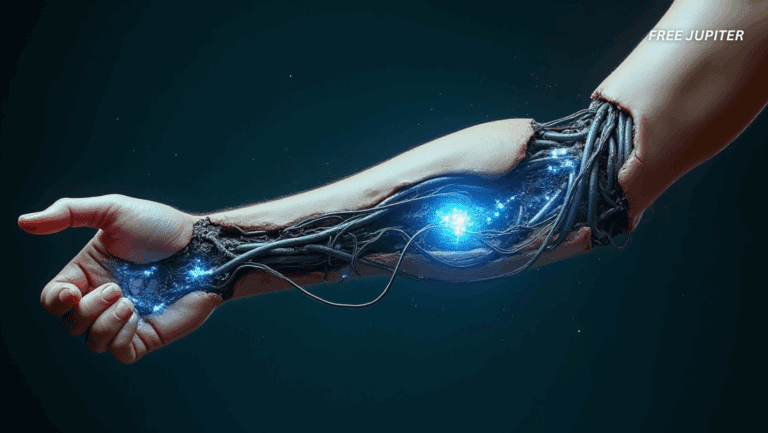Imagine a future where microscopic helpers swoop into the brain, target troubled neurons, and using nothing but a gentle flash of light — help restore movement and function in people facing one of the most challenging neurological conditions. This isn’t science fiction anymore. Thanks to a team of inventive researchers, a new wireless, light-activated nanoparticle system has shown remarkable promise in reversing the effects of Parkinson’s disease in animal models, potentially ushering in a new era for brain health.
The Challenge of Parkinson’s: More Than Just Shaky Hands
Parkinson’s disease is a persistent and progressive disorder of the nervous system, ranking as the second most common condition of its kind. It’s best known for its impact on movement – think tremors, stiffness, and slow motions-but it also brings along a host of other issues, including memory lapses and mood changes. The root cause? The gradual breakdown of dopamine-producing cells in a region of the brain called the substantia nigra. Without enough dopamine, the brain’s communication lines start to falter, leading to the symptoms that define the disease.
But what really throws a wrench into the works is the buildup of a protein called α-synuclein. In Parkinson’s, this protein clumps together into sticky bundles known as Lewy bodies, which are toxic to neurons and accelerate their demise.
Old Solutions, New Problems
For decades, the medical community has fought Parkinson’s with a familiar arsenal: medications that boost dopamine or mimic its effects. These drugs, like levodopa, can provide significant relief – at least for a while. But they don’t stop the relentless march of the disease, nor do they repair the neurons already lost.
Enter deep brain stimulation (DBS), a more recent and high – tech approach. By implanting electrodes deep in the brain and delivering carefully controlled electrical pulses, DBS can help smooth out the motor symptoms of Parkinson’s. Yet, this method is not without its drawbacks. The procedure is invasive, requiring brain surgery, and can sometimes bring about unwanted side effects, including changes in thinking and mood.
Non-invasive alternatives, such as transcranial magnetic stimulation (TMS) and transcranial direct current stimulation (tDCS), have also been explored. While these approaches can tweak brain activity from the outside, they often don’t reach deep enough or target the right areas with enough precision to make a lasting impact.
Read more: New Discovery Prompts Scientists to Warn of Escalating Brain Health Threat
The Nanoparticle Revolution: A Tiny Solution With a Big Impact
Faced with these limitations, a creative team led by Professor Chunying Chen at the National Center for Nanoscience and Technology in China decided to think small-very small. Their new approach, published in Science Advances, centers on a wireless, light-activated nanosystem designed to seek out and revive damaged neurons in the Parkinsonian brain.
The heart of this system is a trio of tiny modules, each with a unique role:
- Photothermal Conversion Module: At the core are gold nanoshells-minuscule spheres that absorb near – infrared light and turn it into gentle heat.
- Targeting Module: Linked to these gold shells is a specialized antibody that homes in on a particular protein (TRPV1) found in abundance on dopamine-producing neurons.
- Degradation Module: The final piece is a short peptide derived from β-synuclein, attached via a light – sensitive linker. This peptide is designed to latch onto and help break down the problematic α – synuclein clumps.
Together, these components form a nanoparticle that can be injected directly into the brain’s affected region. Once in place, a quick zap of near – infrared light from outside the skull activates the system, setting off a chain reaction that both stimulates the neurons and helps clear away toxic protein aggregates.
How It Works: A Symphony of Science
Let’s break down the process, step by step:
- Precise Targeting: After a single injection into the substantia nigra, the nanoparticles travel to dopamine neurons, guided by their TRPV1 antibody “homing device.”
- Wireless Activation: When exposed to an 808 – nanometer near – infrared laser (a wavelength that easily penetrates brain tissue without causing damage), the gold nanoshells heat up – just enough to activate the TRPV1 ion channels on the neurons.
- Neuronal Revival: The heat-sensitive TRPV1 channels open, allowing calcium ions to flow into the cells. This influx sparks electrical activity, essentially “waking up” the dormant or damaged neurons.
- Protein Cleanup: Simultaneously, the light – sensitive linker releases the β-synuclein peptide, which binds to the sticky α-synuclein clumps. This not only helps break them apart but also kickstarts the cell’s own waste-disposal system (chaperone-mediated autophagy), clearing out the toxic debris.
- Restoration: With the neurons reactivated and the protein gunk removed, dopamine production ramps up, and the neural circuits responsible for movement start to function more smoothly.
The Evidence: From Mice to Movement
To test their invention, the researchers used a well – established mouse model of Parkinson’s, in which α-synuclein fibrils are injected to mimic the protein buildup seen in human disease. After delivering the nanoparticles and applying the near-infrared light, they observed a dramatic turnaround.
- Neuron Health: The dopamine neurons in the substantia nigra, previously ravaged by protein aggregates, showed signs of revival. Their networks grew more robust, and their ability to release dopamine improved.
- Motor Function: The treated mice regained much of their lost mobility, moving with greater ease and coordination.
- Safety: Importantly, the approach did not require any genetic tinkering or permanent implants, and the nanoparticles themselves showed no signs of causing harm.
Why This Matters: A New Frontier in Brain Care
This nanoparticle-based system offers several key advantages over existing treatments:
- No Surgery Required: Unlike traditional DBS, there’s no need for wires or electrodes to be implanted in the brain. The system is activated wirelessly with a simple light pulse.
- Pinpoint Precision: By targeting the TRPV1 receptor, the nanoparticles zero in on the exact neurons that need help, leaving healthy cells untouched.
- Two-Pronged Attack: The combination of electrical stimulation and protein cleanup tackles both the symptoms and the underlying causes of Parkinson’s, something current drugs can’t achieve.
- Safety First: By working with the body’s own proteins and receptors, and avoiding genetic modification, the risk of side effects is minimized.
- Parkinson’s disease : alpha-synuclein, a major factor.
Read more: Physicists Finally Catch ‘Free-Range’ Atoms in Action—Confirming A 100-Year-Old Quantum Theory
The Science Behind the Spark: How Light and Heat Wake Up Neurons
The secret sauce in this recipe is the TRPV1 receptor, a protein best known for its role in sensing heat and pain (it’s the same receptor that makes chili peppers feel hot). In dopamine neurons, TRPV1 acts like a gatekeeper, opening up in response to warmth and allowing calcium to flood in. This calcium surge is crucial for triggering the electrical signals that neurons use to communicate.
By using gold nanoshells to generate just the right amount of heat with a flash of near-infrared light, the researchers can turn these receptors on at will-no wires, no surgery, just a beam of light.
Cleaning Up the Mess: Tackling α-Synuclein With β-Synuclein
The second innovation lies in the use of β-synuclein peptides. While α-synuclein is the troublemaker in Parkinson’s, its sibling β-synuclein is much better behaved. In fact, β-synuclein can bind to the sticky parts of α-synuclein and help break up the clumps.
By attaching β-synuclein to the nanoparticles with a light – sensitive linker, the researchers ensure that it’s released only when and where it’s needed-right after the near-infrared light is applied. Once inside the neuron, the peptide not only helps dissolve the protein aggregates but also reactivates the cell’s own cleaning machinery, which is often disrupted in Parkinson’s.
Looking Ahead: From Mice to Humans?
While these results are undeniably exciting, it’s important to remember that the journey from mouse models to human treatments is a long and winding road. There are still many questions to answer:
- How long do the benefits last?
- Can the nanoparticles be safely cleared from the brain over time?
- Will the system work as well in the much larger and more complex human brain?
Nevertheless, the study opens up a tantalizing new direction for Parkinson’s research. By combining the precision of nanotechnology with the power of wireless activation and targeted protein cleanup, scientists may be on the verge of offering new hope to millions of people worldwide.
Read more: This Simple Tennis Ball Test Reveals Your True Biological Age—And Predict If You’ll Live To 100
The Bigger Picture: Nanomedicine’s Bright Future
This work is part of a broader movement in medicine to harness the unique properties of nanoparticles for diagnosis and therapy. Whether it’s delivering drugs to hard-to-reach places, imaging tumors with unprecedented clarity, or, as in this case, rewiring the brain with light, the possibilities are vast.
For Parkinson’s disease, where current treatments often fall short, the prospect of a non-invasive, highly targeted, and multi-functional therapy is especially appealing. While more research is needed before this approach can be tested in people, the groundwork has been laid for a new kind of brain care – one that’s as elegant as it is effective.
Final Thoughts: A Glimmer of Hope
Parkinson’s disease has long been a formidable foe, but with each new discovery, the odds shift a little more in favor of science. The wireless, light – activated nanoparticle system developed by Professor Chen and colleagues is a testament to what’s possible when creativity, technology, and a deep understanding of biology come together.
As research continues, one thing is clear: sometimes, the brightest solutions come in the tiniest packages.










